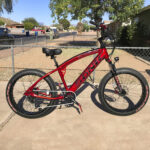When you hear the term “electric bicycle,” you might picture a bulky scooter or a noisy motorcycle. However, an e-bike is much closer to what you already know and love – a traditional bicycle! Imagine your regular bike, but enhanced with seamlessly integrated electrical components: a motor, a battery, and a smart controller. These are the core elements that define electric bicycles and set them apart in the world of personal transportation.
How Electric Bikes Actually Work
Electric bikes are designed to feel familiar. They handle and pedal just like any standard bicycle, often even using the same components you’re accustomed to. The magic of an e-bike lies in its ability to amplify your own pedaling power, not replace it entirely. This boost makes tackling challenging hills, fighting against strong headwinds, and covering longer distances significantly easier and less tiring.
Think of it as having a superpower for cycling. The electric assist kicks in when you need it most, making your ride more enjoyable and accessible, regardless of your fitness level or the terrain.
For a deeper understanding of the mechanics, take a look at this diagram illustrating the interplay of the motor, battery, drivetrain, and charging system within an e-bike:
Share this Image On Your Site
Choosing the Best Electric Bike for You
Just like with traditional bicycles, comfort and component quality remain paramount when selecting an electric bike. However, the electric elements introduce a few additional factors to consider to ensure you choose the right e-bike for your needs and riding style.
Understanding E-bike Motors
E-bike motors are available in a range of power outputs, typically from 200W to upwards of 1,000W. In the US, the legal limit is federally set at 750W, although it’s important to check for any state-specific regulations that might apply in your area.
Consider motor power like horsepower in a car. A higher wattage motor provides more pulling power and can handle heavier loads or steeper inclines with greater ease. However, this increased power comes with a trade-off: higher wattage motors consume battery power more quickly. For example, a 750W motor will deplete the battery faster than a 250W motor, but it will offer more robust performance when needed.
Beyond wattage, the motor’s design and placement significantly impact how an electric bike performs. The two primary types of e-bike motors are hub motors and mid-drive motors.
Hub Motors: These are the most common type and are integrated directly into either the front or rear wheel hub. When engaged, a hub motor propels the wheel forward. While effective, a key drawback of hub motors is their fixed gear ratio relative to the bike’s gears. Imagine driving a car in only one gear – it will move, but it won’t be efficient, especially on hills or varied terrain. Hub motors can lose efficiency in similar situations.
Mid-Drive Motors: EVELO, for example, utilizes a patented mid-drive motor system. These motors are positioned centrally, typically integrated with the bike’s crank and drivetrain. This design offers several significant advantages:
- Enhanced Efficiency and Range: Mid-drive motors leverage the bike’s gears, resulting in more efficient power delivery and extended battery range compared to hub motors for the same battery capacity.
- Superior Hill Climbing Ability: By utilizing the bike’s gears, mid-drive motors can provide optimal torque for climbing steep hills. Shifting to lower gears maximizes the motor’s assistance, making uphill rides much easier.
- Improved Handling and Balance: The central and low positioning of the mid-drive motor contributes to better weight distribution, resulting in more balanced and responsive handling, especially on varied terrain.
Delving into E-bike Batteries
The battery is a critical component influencing an e-bike’s weight, overall style, and riding range. Choosing the right battery type is crucial to ensure it meets your riding needs and preferences. The majority of e-bike batteries fall into two main categories: Sealed Lead Acid (SLA) and Lithium-ion.
Sealed Lead Acid (SLA) Batteries: Once a common standard for electric scooters and early e-bikes, SLA batteries are less prevalent in modern e-bikes. While still used in some electric scooters, e-bikes generally favor lighter and more efficient battery technologies.
Advantages of SLA Batteries:
- Cost-Effective: SLA batteries are typically less expensive upfront.
Disadvantages of SLA Batteries:
- Heavy and Bulky: SLA batteries are significantly heavier and larger than lithium-ion batteries for the same energy capacity.
- Limited Range: They offer a shorter riding range compared to lithium-ion batteries.
- Shorter Lifespan: SLA batteries have a shorter cycle life, typically around 100-300 full charge cycles.
- Maintenance Requirements: They may require more maintenance and ideally should be charged immediately after each use.
Lithium-ion Batteries (and variants like Lithium Polymer, Lithium Manganese, etc.): Lithium-ion technology represents the cutting edge in e-bike batteries. They offer a significantly improved lifespan, are considerably lighter, and require minimal maintenance.
Advantages of Lithium-ion Batteries:
- Lightweight and High-Capacity: Lithium-ion batteries are remarkably lightweight for their energy storage capacity. For instance, a high-capacity 36V 10Ah lithium-polymer battery can weigh as little as 6 pounds.
- Extended Riding Range: They provide a longer riding range. A typical lithium-ion battery can enable you to travel up to 40 miles in pedal-assist mode or around 20 miles using throttle-only operation, depending on terrain and usage.
- Longer Lifespan and Durability: Lithium-ion batteries boast a longer lifespan, typically lasting for approximately 800 charge cycles or around 3 years with regular daily use.
- Low Maintenance: They are largely maintenance-free, simplifying ownership.
Disadvantages of Lithium-ion Batteries:
- Higher Initial Cost: Lithium-ion batteries are more expensive upfront, contributing to a higher overall e-bike price, typically starting from around $1,500 to $3,000 and upwards for quality e-bikes.
Understanding E-bike Controllers
The controller is your interface for operating the electric assist on your e-bike. Typically mounted on the handlebars for easy access, controllers come in two primary styles: pedal-activated and throttle-based.
Pedal-Activated Controllers (Pedal Assist): Pedal-assist systems engage the motor as you pedal. There’s no need for a separate throttle; simply pedaling activates the electric assistance. These systems usually include a handlebar-mounted controller that allows you to adjust the level of assistance. You can select from different levels, ranging from minimal assistance to a significant power boost, tailoring the support to your needs and terrain.
Throttle-Based Controllers: Throttle controllers function similarly to a motorcycle throttle. They can be twist-grip or thumb-press types. Activating the throttle, without necessarily pedaling, engages the motor and provides electric propulsion. Some e-bikes equipped with throttles can be ridden solely using the throttle, without any pedaling required.
In general, electric bikes are designed for ease of use, riding, and maintenance. Beyond the standard maintenance of a regular bicycle, e-bikes require minimal additional upkeep.
How to Ride an Electric Bike
Operating an electric bicycle is incredibly intuitive. As the rider, you have three primary modes of operation to choose from, allowing you to customize your riding experience:
Pedal Only Mode
You can ride an e-bike just like a traditional bicycle, pedaling without any electric assistance. The motor does not create any noticeable drag or resistance, so it feels exactly like riding a regular bike. Depending on the e-bike model, you’ll have gears to tackle varying terrain, ranging from 3-speed to 8-speed systems, or even advanced options like the NuVinci® N360™ continuously variable transmission for seamless gear changes.
Pedal-Assist Mode (Electric-Assist)
This mode blends your pedaling power with electric augmentation. Once activated via a handlebar-mounted button, the motor smoothly provides power as you pedal. You can still shift gears to optimize for torque or speed, just like on a regular bike. Pedal-assist mode creates an effortless cycling experience, making hills feel flatter and allowing you to enjoy the ride and scenery without excessive exertion.
Pedal-assist typically offers multiple levels of assistance, such as Low (30%), Medium (60%), and High (100%). These percentages indicate the proportion of additional power the motor contributes to your pedaling effort. Low provides a gentle 30% boost, while High can essentially double your pedaling power. Switching between assist levels is usually done with a simple button press.
Electric-Only Mode
This mode allows you to relax and let the motor do the work. To engage electric-only mode, simply use the throttle (typically located on the left handlebar). Activating the throttle engages the motor and propels you forward without pedaling. Releasing the throttle allows you to coast, pedal, or stop. It’s important to note that, due to federal regulations, electric-only mode is typically limited to a top speed of 20 miles per hour in the US.
E-bike Laws and Regulations: Do You Need a License?
Electric bikes are a relatively recent development in personal transportation in many regions, leading to some confusion regarding their legal status. In the US, federal law classifies electric bicycles similarly to regular bicycles, provided they meet two key criteria: (1) the top speed in electric-only mode is capped at 20 miles per hour, and (2) the motor’s power output must not exceed 750W.
EVELO e-bikes, for example, are designed to comply with these federal regulations. Their electric-only mode is limited to 20 mph, and their motors are rated at 250W, well within the federal limit.
As a result, under federal law, e-bikes generally do not require special registration, licensing, or insurance to operate. Furthermore, they are often granted the same privileges as traditional bicycles, such as access to bike lanes and paths.
However, it’s crucial to be aware that state and local regulations can vary. While many states align with the federal guidelines, some may have specific requirements or restrictions regarding e-bike usage. If you have questions about e-bike laws in your specific area, it’s advisable to consult local authorities or resources for accurate information. Regardless of legal requirements, prioritizing safety is paramount. Wearing a helmet, using lights, and utilizing reflective gear are highly recommended for rider safety, even if not legally mandated in your location.


